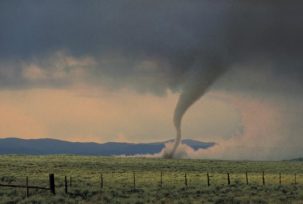What Causes Tornadoes?
Tornadoes are among the most fearsome and recognizable weather phenomena, ravaging whole communities and homesteads on a yearly basis. They’re no joke, really: in 1925, the infamous Tri-State tornado was responsible for 700 deaths and 15,000 demolished homes in a single night, while 2014 saw the month of April ushering in a total of 75 tornadoes between North Carolina and Nebraska. In all, tornadoes hit the U.S. over 1100 per year and wreak havoc on property and welfare; tornado wind speeds can hit up to 318 mph. What is a tornado, and why are they so dangerous?

Tornadoes are complicated, and are something of an anomaly: no one is quite sure why tornadoes form, or even how they form. Even though we don’t know much about their origins, tornadoes are weather phenomena that follow a pretty specific formula: they tend to occur mainly from April through June and are most common in a region known as “Tornado Alley”, which includes areas of Texas, Oklahoma, Kansas, and Nebraska.
Of the relatively small about of knowledge we have about tornadoes, three conditions stand out as being especially conducive to hurricanes. For one, hurricanes require moisture. Secondly, hurricanes thrive in environments of atmospheric instability, where air moves upward extremely quickly. Third, they occur when there are clashing air fronts, namely low-elevation, warm air from the southern Gulf Coast colliding with cold, high-rising air from the Rocky Mountains. When these two fronts meet, they create a supercell. A supercell is kind of like a thunderstorm in a vortex; it swirls in the air above the land.
After that, scientists can only guess what happens. One educated guess posits that when the cool, Rocky Mountain air blows over the warm air from the Gulf, it creates a horizontal vortex. The horizontal vortex is then “flipped” or dragged onto its side, becoming a vertical vortex, as the warm air rises towards the top and hail or rain pulls down at the bottom.
Another theory claims that a tornado begins its life as a vertical vortex: the air masses collide, the warmer mass rises, creating a hollow, vacuum-like column in the middle of the supercell. Meanwhile, the winds are spiraling upwards with enormous velocity. The scientific name for a tornado that forms this way is a mesocyclone; it will form miles above the land but will be pulled down to the earth’s surface as the cold air plummets downwards.
Either way, a tornado becomes a tornado the moment it touches ground, causing the catastrophic winds and suction force that can do so much damage.
